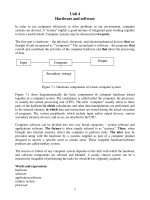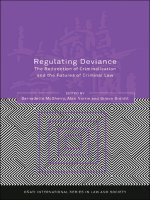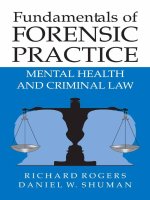GOOD MEDICAL PRACTICE PROFESSIONALISM, ETHICS AND LAW pptx
Bạn đang xem bản rút gọn của tài liệu. Xem và tải ngay bản đầy đủ của tài liệu tại đây (3.18 MB, 464 trang )
This page intentionally left blank
GOOD MEDICAL PRACTICE
Good Medical Practice: Professionalism, Ethics and Law
brings together the infor-
mation central to the professional, ethical and legal requirements of being a doctor.
It covers a core curriculum for medical students, doctors in training and international
medical graduates preparing for the Australian Medical Council examinations. It will
also be useful for busy doctors looking for answers to issues that arise in practice,
and for approaches that meet professional standards.
The book’s central premise is that effective and compassionate practice
depends not only upon sound medical knowledge and clinical competence, but also
upon good communication skills, an empathetic attitude and respect for all patients,
truthfulness, self-reflection and an awareness of the responsibilities arising under
the law.
Good Medical Practice
encapsulates these attributes and includes prac-
tice management, inter-professional relationships, sexual misconduct, complaints
processes, the Australian health care system and doctors’ health within its broad
and comprehensive purview. Complex perennial topics such as the allocation of
resources, abortion and mental illness are also thoroughly explored.
Written by specialist practitioners representing both the medical and legal pro-
fessions, each with vast teaching experience, this is a unique, timely and accessible
text that reinforces and redefines a contemporary focus on professionalism in medi-
cal practice.
Kerry J Breen AM, MB BS, MD (Melb), FRACP is a consultant physician and
gastroenterologist. He is currently a part time member of the Federal Administra-
tive Appeals Tribunal and Commissioner of Complaints of the National Health and
Medical Research Council.
Stephen M Cordner AM, MA (Lond), MB BS, B Med Sc, Dip Crim, DMJ, FRCPath,
FRCPA is Professor of Forensic Medicine at Monash University and Director of the
Victorian Institute of Forensic Medicine (VIFM).
Colin JH Thomson LLB, BA,LLM (Syd) is Professor of Law in the Faculty of Law at the
University of Wollongong. He is currently Chairman of the Australian Health Ethics
Committee of the National Health and Medical Research Council.
Vernon D Plueckhahn AM, OBE, ED, MD (Adel), Hon MD (Monash), FRACP, FRCPath,
FRCPA, FAMA, FCAP, FAACB, MIAC is a retired Consultant Forensic Pathologist
and Honorary Associate Professor of Forensic Medicine at Monash University.
KERRY J BREEN
STEPHEN M CORDNER
COLIN JH THOMSON
VERNON D PLUECKHAHN
GOOD MEDICAL
PRACTICE
PROFESSIONALISM, ETHICS AND LAW
CAMBRIDGE UNIVERSITY PRESS
Cambridge, New York, Melbourne, Madrid, Cape Town, Singapore,
São Paulo, Delhi, Dubai, Tokyo
Cambridge University Press
The Edinburgh Building, Cambridge CB2 8RU, UK
First published in print format
ISBN-13 978-0-521-18341-3
ISBN-13 978-0-511-67777-9
© Kerry J Breen, Stephen M Cordner, Colin JH Thompson, Vernon D Plueckhahn
2010
2010
Information on this title: www.cambrid
g
e.or
g
/9780521183413
This publication is in copyright. Subject to statutory exception and to the
provision of relevant collective licensing agreements, no reproduction of any part
may take place without the written permission of Cambridge University Press.
Cambridge University Press has no responsibility for the persistence or accuracy
of urls for external or third-party internet websites referred to in this publication,
and does not guarantee that any content on such websites is, or will remain,
accurate or appropriate.
Published in the United States of America by Cambridge University Press, New York
www.cambridge.org
eBook
(
NetLibrar
y)
Pa
p
erback
FOREWORD
This imposing book has grown to full maturity, following its childhood and
adolescence as two precursors published respectively in 1994 and 1997. The
successive alterations in the title are a reflection of its maturation and growth.
Law and Ethics in Medicine for Doctors in Victoria, published in 1994, grew
from its conception as an innovative professional practice program, a short course
to help young doctors in the transition from hospital training to independent
medical practice, developed by three of the authors of the current book, Drs
Breen, Cordner and Plueckhahn. It was a concise description of aspects of law
and ethics that related to medical practice. They were presented as ‘add ons’ to
be accessed and applied when they became necessary. Ethics, Law and Medical
Practice, published in 1997, recognised by its title and its emphasis that ethics
and law influenced many aspects of medicine and the book integrated these facets
more comprehensively into the context of medical practice. The title of the current
book, Good Medical Practice: Professionalism, Ethics and Law, gives a clue to its
much more ambitious scope. It recognises that good medical practice requires the
knowledge and application of law and ethics and that there is a range of additional
components that have come to be depicted by the term ‘professionalism’. It is also
significant that a fourth author has been added to the three well-qualified authors
of the two earlier volumes. Colin Thomson brings his extensive background as
an academic lawyer with a particular expertise in the legal and ethical aspects
of medical practice and health research to this edition. Like Kerry Breen he has
been Chair of the Australian Health Ethics Committee of the National Health and
Medical Research Council.
The change in title and scope of the book reflect four complementary devel-
opments.
The first is that the authors have quite heroically expanded the content of
the book to include all aspects of medical practice that are additional to the
knowledge of medical science and its application to the diagnosis and treatment
of patients. Some of these components, such as communication skills and dealing
with distressed or dying patients, overlap with skills that are normally taught in
clinical education. Others, such as the complex ethical issues that often confront
medical care and the expanding legal environment that provides the boundaries
within which such care must be practised, are not usually addressed in medical
texts but are central to good medical practice.
v
vi Foreword
The second development is a change in medical practice itself over the last
two decades, a change that has seen much greater emphasis paid to medico-legal
issues, ethical judgments and respect for patient autonomy. No longer is it possi-
ble to practise medicine in a cosy, traditional, paternalistic two-way relationship
between the doctor and the patient. Legal parameters set absolute boundaries, but
professionalism demands a more sophisticated knowledge and practice, applying
ethical principles in difficult situations calling upon wisdom and judgment. More-
over, the patient’s right and frequent wish to be included in the decision-making
process is now recognised and must be respected. This book deals extensively and
sensitively with all these issues.
The third development is the much greater power of medicine to save or
preserve life using sophisticated technology. While this has brought monumental
benefits to people with acute illnesses often accompanied by multiple organ failure,
it also raises ethical dilemmas in the management of people with chronic illnesses
whose expectations of that technology may exceed the utility of even the most
sophisticated interventions. Where does a patient’s right to autonomy end and
when do sound clinical judgment and common sense become more important? Is
it appropriate to preserve the life of a very premature infant with a high risk of
permanent disability? When does withholding or withdrawing life support differ
in nature from euthanasia? Decisions like these that seek to balance the power
and promise of medical technology, the heightened expectations of seriously ill
patients and their families, and the ethical and legal constraints of good medical
practice require an understanding of legal boundaries as well as a sound ethical
framework to guide decision making.
The fourth factor is that, with the greater capability of medical technology
together with the cost of that technology, the questions of distributive justice
become more pressing. Who should have priority to what resources and on what
grounds? How should the cost be fairly apportioned? These questions can be
considered on many levels. For example, how much of our resources should
be used for the acute care in hospitals of patients with low quality of life and
with little prospect of real improvement, compared with preventive measures in
the wider community? In an era where donor organs are becoming increasingly
harder to access, what criteria do we use to decide who should receive one?
What degree of ‘queueing’ is appropriate for chronic but not life-threatening con-
ditions? The issue of distributive justice becomes even more troublesome when
we look at the different health outcomes in different communities in our own
country, especially among Aboriginal and Torres Strait Islander people. And
since ethics is not confined by national boundaries, how should we respond
when we see, in poor countries in our region and beyond, the terrible effects
of diseases that are preventable, or easy to treat using resources we have in
abundance?
Foreword vii
The authors, with their extensive and diverse backgrounds, are ideally
equipped to deal with these complex topics. They have created an important
work that provides an invaluable guide to good medical practice for new medical
graduates and established practitioners alike.
RICHARD LARKINS, AO
Vice-Chancellor and President
Monash Uni ver sity
CONTENTS
Foreword v
List of tables xxi
Preface xxii
Preface to the 1997 edition xxv
Acknowledgments xxvii
About the authors xxix
Table of cases xxxi
Table of statutes xxxii
1 Ethical principles for the medical profession 1
1.1 Some historical context 1
1.2 What are ethics? 2
1.3 An introduction to ethical thinking 2
1.4 A modern framework for discussing medical ethics 4
1.5 Qualities of an ‘ethical’ doctor; virtue ethics 5
1.6 Other desirable qualities 8
1.7 Modern codes of medical ethics 9
1.8 The rights of patients 10
1.9 Upholding ethical codes of conduct 12
1.10 The mutability of medical ethics 12
1.11 The law and medical ethics in conflict 13
1.12 Conflicts between ethical principles 13
1.13 Ethics beyond the doctor–patient relationship 14
1.14 Ethics and limited resources 15
References 15
Additional reading 17
2 Ethical and legal responsibilities of medical students 18
2.1 Considerations before enrolment 18
2.2 Criteria for enrolment: selection procedures 19
2.3 Registration of medical students 20
2.4 Objectives of the medical course 21
2.5 Professional ethics for students 21
ix
x Contents
2.6 The student and the health-care team 26
2.7 Student health 27
2.8 Responsibilities of and professional ethics for medical teachers
and supervisors
28
References 30
Additional reading 32
3 Communication skills 33
3.1 Obstacles to effective communication 34
3.2 The use of communication skills in medical practice 36
3.3 Appreciating psycho-social factors in patients who seek
medical help
38
3.4 The physical examination 39
3.5 Transcultural issues and the use of interpreters 39
3.6 Concluding the consultation 40
3.7 Communicating when things go wrong 41
3.8 Coping with angry patients 41
3.9 Medico-legal examinations 42
3.10 Touching patients 42
3.11 Talking about sex and sexuality 42
3.12 Talking with the dying 43
3.13 Doctors and other health-care professionals as patients 44
3.14 The importance of written communication 44
3.15 Intra- and inter-professional communication and relationships 44
References 45
Additional reading 47
4 Consent and informed decision making 49
4.1 Elements of valid consent 50
4.2 Implied, oral or written consent 50
4.3 Consent for surgical or other major invasive procedures 52
4.4 Therapeutic privilege and withholding information 56
4.5 Patients who may not be legally able to consent 57
4.6 Consent of children and teenagers 57
4.7 Children who are intellectually disabled 60
4.8 Substitute decision makers 61
4.9 Consent for special procedures 63
4.10 Treatment without consent 64
4.11 Consent and the mentally ill 65
Contents xi
4.12 Refusal of treatment
66
4.13 Refusal of blood transfusion 66
4.14 Informed consent and the performance record of the doctor 67
References 67
5 Confidentiality, privacy and disclosure 69
5.1 Confidentiality distinguished from privacy 70
5.2 The ethical basis of confidentiality 70
5.3 Confidentiality in the doctor’s surgery 71
5.4 Confidentiality and medical reports and certificates 72
5.5 Sharing information in the health-care team 73
5.6 Exceptions to the duty of confidentiality 74
5.7 The legal basis of confidentiality 75
5.8 Statutory authorisation of disclosure 75
5.9 Disclosure in court 76
5.10 Public interest and disclosure 78
5.11 Disclosure to the police 78
5.12 The legal basis of privacy 79
5.13 Enforcement provisions 84
5.14 Other considerations 84
References 85
6 Medical records, reports and certificates 87
6.1 The importance of medical records 87
6.2 What is a medical record? 88
6.3 What should be recorded? 88
6.4 Guidelines for making medical records 91
6.5 Medical records and the computer 92
6.6 Safety and security of records 92
6.7 Ownership of medical records 93
6.8 Access to medical records 94
6.9 Medical records and privacy legislation 95
6.10 Patient access under privacy law 95
6.11 Retention and destruction of medical records 96
6.12 Retention of medical records when a doctor retires or dies 97
6.13 Medical records and the courts 98
6.14 Medical records and research 98
6.15 Medical reports 99
6.16 Medical certificates 99
References 102
xii Contents
7 Negligence, professional liability and adverse events 103
7.1 Causes of action against doctors 104
7.2 Actions for negligence 105
7.3 The doctor’s duty of care 106
7.4 The required standard of care 109
7.5 The circumstances of negligence 110
7.6 Assessment of damages 114
7.7 Statutes of limitations 115
7.8 Vicarious liability 115
7.9 The medical indemnity crisis and its outcomes 116
7.10 Adverse events and their prevention 117
7.11 Preventing claims for negligence/risk management 118
7.12 Open disclosure 119
7.13 The role of medical indemnity organisations 120
References 121
Additional reading 123
8 The regulation of the medical profession 124
8.1 Historical background 126
8.2 The establishment and membership of boards 127
8.3 Functions of medical boards 127
8.4 The Australian Medical Council 128
8.5 Medical registration 129
8.6 Registration/recognition as a specialist 132
8.7 Mutual recognition of registration 132
8.8 Registration of medical students 133
8.9 Complaints and disciplinary hearings 133
8.10 Complaint-handling processes 134
8.11 The investigation of complaints 134
8.12 Disciplinary hearings 135
8.13 Formal hearings 135
8.14 What constitutes unprofessional conduct? 136
8.15 Codes of conduct 139
8.16 Nature of complaints subject to formal hearings 139
8.17 Trust and the medical practitioner 140
8.18 Sexual misconduct 140
8.19 The impaired practitioner 140
8.20 Illnesses leading to impairment 141
8.21 Notification and handling of possible impairment 142
8.22 The poorly performing doctor 143
Contents xiii
8.23 Advertising by doctors
143
8.24 Doctors who practise alternative medicine 143
References 144
9 Health care complaints systems 145
9.1 Health complaints commissions 147
9.2 Health-care professionals covered by legislation 147
9.3 Who may lodge a complaint? 148
9.4 ‘Sharing’ of complaints 148
9.5 What constitutes a complaint? 149
9.6 How complaints are handled and resolved 149
9.7 The nature and source of complaints against doctors 151
9.8 Preventing complaints and responding to them 154
Reference 155
10 The doctor and sexual boundaries 156
10.1 What constitutes sexual misconduct 157
10.2 The incidence of sexual misconduct 158
10.3 Reasons for under-reporting or failure to complain 159
10.4 The psychodynamics of the breach of professional sexual
boundaries
159
10.5 Why sexual misconduct by doctors is ethically unacceptable 161
10.6 Reporting complaints – the doctor’s ethical duties 162
10.7 Handling complaints of sexual misconduct 162
10.8 Disciplinary outcomes 163
10.9 False accusations 163
10.10 Benzodiazepines and sexual fantasy 164
10.11 Prevention of sexual misconduct by doctors 164
10.12 Intimate examinations and the use of chaperones 165
10.13 Sexual abuse and sexual harassment outside the
doctor–patient relationship
165
References 166
Additional reading 167
11 Personal health of the doctor: illness and impairment 169
11.1 Ethical and legal responsibilities 169
11.2 The extent of health problems for doctors 170
11.3 Why doctors become unwell 172
11.4 Early warning signs 173
11.5 Assisting colleagues 174
xiv Contents
11.6 Treatment and rehabilitation 175
11.7 Caring for yourself and your family 176
11.8 Treating other doctors 177
11.9 Doctors who carry a transmissible disease 177
11.10 Sexual misconduct and impairment 179
11.11 The elderly doctor 179
References 180
Additional reading 183
12 Maintenance of professional competence 184
12.1 The terminology of maintaining professional competence 185
12.2 Existing outcome evaluation/audit programs 190
12.3 Other accreditation or certification programs 190
12.4 Quality assurance in private medical practice 191
12.5 Future directions and contentious areas 192
References 193
13 Ethics and the allocation of health-care resources 195
13.1 Levels of decision making in the allocation of resources 196
13.2 New approaches to resource allocation 197
13.3 Competing conceptions of justice in allocating health-care
resources
198
13.4 Other ethical values in the allocation of health-care resources 199
13.5 Ethical issues in applying evidence to health-care resource
allocation
201
13.6 The doctor and resource allocation 201
13.7 The law and resource allocation 204
References 204
Additional reading 206
14 The Australian health-care system 208
14.1 An overview of the health-care system 208
14.2 Government health departments 210
14.3 Medicare Australia (formerly the Health Insurance
Commission)
211
14.4 Medicare regulations relating to doctors 212
14.5 Specialist recognition for Medicare purposes 215
14.6 The Pharmaceutical Benefits Scheme 215
14.7 Private health insurance 217
14.8 The role of universities and colleges 217
14.9 Teaching hospitals 218
Contents xv
14.10 The Australian Medical Association and other associations
219
14.11 Australian Council on Healthcare Standards 219
14.12 The Australian Commission on Safety and Quality in Health
Care
220
14.13 Registration of other health-care providers 220
14.14 Alternative health-care providers 220
14.15 The National Health and Medical Research Council 221
References 222
Additional reading 222
15 The doctor and interprofessional relationships 223
15.1 The legal and ethical context 224
15.2 Nurses 224
15.3 Pharmacists 228
15.4 Ambulance officers/paramedics 233
15.5 Advice to doctors about requesting an ambulance 234
15.6 Clinical psychologists 235
15.7 Dentists 235
15.8 Dietitians 236
15.9 Occupational therapists 237
15.10 Optometrists 238
15.11 Physiotherapists 239
15.12 Podiatrists 240
15.13 Prosthetists and orthotists 241
15.14 Radiographers 242
15.15 Social workers 242
15.16 Speech pathologists 243
15.17 Chaplains and pastoral-care workers 244
15.18 Interpreters 245
15.19 Lawyers 247
15.20 Medical librarians 247
15.21 Police 248
15.22 Complementary and alternative medicine practitioners 249
15.23 Chiropractors 252
15.24 Osteopaths 252
References 253
Additional reading 256
16 Entering and leaving practice and practice management 257
16.1 Importance of good practice management 257
16.2 Choosing your career 258
16.3 Entering private practice 259
xvi Contents
16.4 Setting up a medical practice 259
16.5 Recognition by Medicare Australia 261
16.6 Medical indemnity 261
16.7 Selecting, employing and training staff 262
16.8 Caring for staff and staff safety 262
16.9 Infection control and patient safety 263
16.10 After-hours arrangements 263
16.11 Financial, business and legal advice 263
16.12 Marketing the practice 263
16.13 Planning for a healthy approach to work 264
16.14 Closing a medical practice 264
16.15 Planning for retirement 264
References 265
Additional reading 265
17 Clinical research 266
17.1 Codes of ethics in clinical research 266
17.2 Research governance 267
17.3 What constitutes clinical research 268
17.4 Requirements for ethically acceptable research 268
17.5 Special areas in medical research 270
17.6 Standards for responsible research conduct 273
17.7 Patenting of medical procedures 275
17.8 Research undertaken in private medical practice 275
17.9 Misconduct in medical research 275
17.10 Biomedical research using animals 276
References 276
Additional reading 278
18 Prescribing and administering drugs 279
18.1 Standard schedule of drugs and poisons 280
18.2 Some relevant terminology 282
18.3 Prescribing drugs – general advice 283
18.4 Computer-generated prescriptions 284
18.5 Authority prescriptions 285
18.6 Prescribing drugs of dependence 285
18.7 Storage and record keeping of drugs of dependence 287
18.8 Relationships of doctors with pharmacists 288
18.9 Prescribing in an emergency 288
18.10 Prescribing for patients travelling abroad 288
18.11 Prescribing in hospitals and nursing homes 289
18.12 Prescribing or dispensing unregistered drugs 289
Contents xvii
18.13 Prescribing drugs outside their specific indications
289
18.14 Prescribing benzodiazepines 290
18.15 Generic versus trade names 290
18.16 Responsibilities of patients 290
18.17 Relationships with pharmaceutical and medical device
companies
291
References 292
19 Diagnosing and certifying death and the role of the coroner 295
19.1 Recent developments in the diagnosis of death 295
19.2 Responsibilities of doctors attending a person thought
to be dead
296
19.3 Responsibility for completing the death certificate 297
19.4 The cause of death 298
19.5 The different types of death certificates 299
19.6 Providing the Death Certificate 300
19.7 Deaths reportable to coroners 301
19.8 Surgical, anaesthetic and adverse event-related deaths 304
19.9 Death related to fractured neck of femur in the elderly 305
19.10 Cremation 306
19.11 The diagnosis of brain death 308
19.12 Brain death and transplantation 309
19.13 The use of tissues removed at autopsy 311
References 311
Additional reading 312
20 Births, reproductive technology, family law and child
protection
313
20.1 Notification of births (including stillbirths) 313
20.2 Reproductive technology 314
20.3 Parentage issues in AID and IVF 317
20.4 Surrogate motherhood 318
20.5 Family Law Act 1975 (Cth) 319
20.6 Child abuse and child protection 320
References 322
21 Termination of pregnancy and related issues 323
21.1 Abortion – historical background 323
21.2 Abortion law in Australia 324
21.3 The law in Australian Capital Territory and Victoria 326
21.4 Abortion and conscientious objection 327
xviii Contents
21.5 Proportionality of risk 327
21.6 Late term (third trimester) abortion 328
21.7 Child destruction 329
21.8 Concealment of birth 329
References 330
Additional reading 330
22 Withholding or withdrawing treatment in the seriously
or terminally ill
331
22.1 Treatment decisions for newborn infants 331
22.2 Withholding or withdrawing treatment from children 332
22.3 Refusal of medical treatment 333
22.4 Advance care plans and directives 334
22.5 Post-coma unresponsiveness 336
22.6 ‘Not for resuscitation’ orders 337
22.7 Euthanasia and physician-assisted suicide 339
22.8 The stated position of the medical profession 340
References 342
Additional reading 343
23 The law and the mentally ill 344
23.1 Definition of mental illness 346
23.2 Admission procedures 347
23.3 Involuntary admission 347
23.4 Use of seclusion and restraint 348
23.5 People incapable of caring for themselves 348
23.6 Community treatment orders 349
23.7 Security admissions 349
23.8 Patients’ rights 349
23.9 Community and official visitors 350
23.10 Special treatment procedures 350
23.11 Consent to non-psychiatric treatment 351
23.12 Review and appeal procedures 351
References 352
24 The law and courts of law in Australia 353
24.1 Sources and forms of law in Australia 353
24.2 Legislation 354
24.3 The Australian Federation 354
24.4 Codification 355
Contents xix
24.5 Subordinate legislation
355
24.6 Schedules 355
24.7 Common law: colonial origins 356
24.8 Common law: the practice of precedent 356
24.9 Common law: the structure of precedent 357
24.10 Types of Australian law: civil and criminal law 357
24.11 Common law and equity 358
24.12 Standards of proof 358
24.13 Civil wrongs: contract and torts 358
24.14 Crimes 359
24.15 Courts of law in Australia 360
24.16 Tribunals 365
24.17 Commonwealth Ombudsman 365
References 366
Additional reading 366
25 Medico-legal examinations and reports, court procedures
and expert evidence
367
25.1 Medico-legal reports 367
25.2 Problems arising in medico-legal examinations 371
25.3 Expert witness reports 372
25.4 Court procedures 374
25.5 The adversarial system 374
25.6 The giving of evidence 376
25.7 Evidence of fact 377
25.8 Hearsay evidence 377
25.9 Appearing in court 379
25.10 Subpoena 379
25.11 The doctor as a witness 380
25.12 Expert evidence 380
25.13 The experience of being a medical witness 382
25.14 Fees for court appearances 384
25.15 Doctors and jury duty 384
References 384
Additional reading 385
26 Other legislation relevant to medical practice 386
26.1 Social security legislation 386
26.2 Testamentary capacity and witnessing wills 387
26.3 Statutory declarations 387
26.4 Responsibilities of doctors in relation to injury or accident 388
xx Contents
26.5 Workers compensation and rehabilitation 388
26.6 Pre-employment medical examinations 390
26.7 Motor vehicle accidents 390
26.8 Fitness to drive a motor vehicle 391
26.9 Doctors’ responsibilities to others at risk 392
26.10 Child abuse 393
26.11 Infectious diseases 393
26.12 Doctors and the intellectually disabled 395
26.13 Notification of cancer 395
26.14 Alcohol and drug-dependent people 396
26.15 Blood samples from people accused of serious crime 396
26.16 Trade practices legislation 397
26.17 Firearms legislation 397
References 397
Appendix 1: AMA Code of Ethics – 2004 399
Index 406
TABLES
4.1 Approach to assessing decision-making capacity 58
4.2 Guardianship legislation and guardianship boards/tribunals 62
5.1 Health privacy legislation and websites 81
8.1 Contact details of state and territory medical boards, the Australian
Medical Council and the Confederation of Postgraduate Medical
Education Councils
125
9.1 Health complaints commissioners (or equivalent) 146
11.1 Names, addresses and telephone numbers of doctors’ health
advisory services
175
18.1 Legislation controlling prescribing and using drugs 280
19.1 Legislation providing for the definition of death 296
19.2 Legislation providing for the certification of death 297
19.3 Comparison of states’ coroners Acts: reportable deaths generally 302
19.4 Comparison of states’ coroners Acts: deaths in custody and other
specific circumstances
303
20.1 Births, deaths and marriages registration Acts – summary of
notification obligations
314
20.2 Notification of suspected child abuse 321
22.1 Legislation regarding advance care directives and refusal of
treatment
335
23.1 Mental health legislation and mental health review tribunals 345
xxi
PREFACE
The primary purpose of this book is to provide in a single accessible format
information central to the professional, ethical and legal requirements of being
a doctor. It covers a core curriculum for medical students who must obtain a
grounding in the elements of what constitutes being a medical professional [ 1–2].
The same material is essential for doctors in training and for international medical
graduates coming to work in Australia. This book should be a useful and readily
accessible starting point for busy doctors looking for answers to issues as they
arise in practice. This edition brings together updated material generally not found
in textbooks of clinical medicine. Although most doctors are now equipped to
seek information electronically, this can take time as information is not accessed
readily or integrated at a single source, may not be relevant to the local setting
and may not be quality controlled.
Since the 1997 edition of our book [3] there have been significant develop-
ments in regard to the importance of professionalism. Medical boards here and
overseas have focused attention on the breadth of professional skills needed for
good medical practice; indeed the UK General Medical Council’s primer for doc-
tors is called just that, Good Medical Practice [4]. More recently, medical indem-
nity organisations and health-care institutions have been active in promoting good
professional attitudes and behaviour, under the banner of ‘risk management’, to
reduce the risk of adverse outcomes.
Australian medical colleges have agreed to have their education and training
programs accredited by the Australian Medical Council (AMC) and this has
resulted in a greater emphasis on professionalism and ethics for specialists in
training. The AMC clinical examination for international medical graduates now
specifically addresses professional attitudes.
At its core, medicine remains the delivery of care to people who are unwell and
are seeking help. The effective and compassionate practice of medicine requires a
combination of medical knowledge, clinical competence, and sound professional
attitudes and skills. In the distant past, professional attitudes and skills were
known as a ‘good bedside manner’ and were not taught formally. It was assumed
that young doctors would somehow acquire such skills, perhaps by observation
and experience. In Australia, since the 1988 Doherty Report [5], the medical
profession, especially those sections responsible for the basic medical education,
has identified professional skills as something that can and must be taught.
xxii
Preface xxiii
‘Professionalism’ is a convenient shorthand term to describe the professional
attributes required (over and beyond simply having adequate knowledge of
medicine and adequate procedural ability) for effective medical practice that the
community can trust. Professionalism covers a wide range of elements, including
good communication skills, an empathetic attitude, the virtues of self-reflection,
truthfulness and dependability, cultural awareness in our multicultural society
and awareness of responsibilities arising under relevant laws pertaining to medi-
cal practice. Above all it covers an assumption that a person wishing to practice
medicine effectively will bring positive attitudes to all the roles involved in being
a doctor. Used in this way, the term ‘professionalism’ is consistent with the focus
of the Victorian Professional Practice Program, which in 1991 and 1992 was the
basis of an early version of this book [6].
Many new influences have been brought to bear on the doctor–patient relation-
ship, including community expectation of excellent outcomes of all interventions,
a changing legal interpretation of medical negligence, the conundrums of infinite
need versus finite resources, awareness of preventable adverse events, commercial-
isation and corporatisation of medicine, a patchwork of federal and state privacy
laws, additional forms of accountability for doctors with closer scrutiny of pro-
fessional performance, alertness to doctors’ ill health leading to impairment, and
demands for programs of maintenance of professional standards. Despite these
influences, the practice of clinical medicine remains very rewarding. As this book
unfolds, we hope the reader will recognise that meeting the professional, ethical
and legal requirements of medical practice, while demanding, is consistent with
approaches competent doctors have used to provide effective and appreciated ser-
vice for patients over many years. Primary features of such practice remain respect
for patients, the personal integrity of the doctor and good communication.
Our approach in this book remains essentially pragmatic. While the text nec-
essarily explores the underpinning themes of ethical theory and medical law, and
addresses topical issues such as euthanasia and abortion, it does not probe the
ethical or legal detail. Our fundamental aim is to provide core information for
medical students and doctors in training, and to guide medical practitioners who
are faced in their daily work with practical problems in consultation with their
patients.Whileeverycarehasbeentakentostrivetobeaccurateanduptodate,
the reader should not rely on this book as a source of legal advice. There now
exist in Australia several excellent texts on ethics in health care, and on medical
law, which are recommended where relevant, and ample references and suggested
additional reading are provided for readers who wish to explore any topic in more
depth.
KJ BREEN
SM CORDNER
CJH THOMSON
VD PLUECKHAHN









